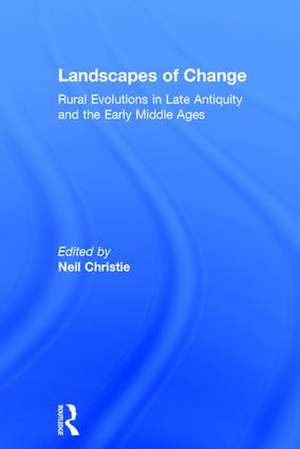Landscapes of Change: Rural Evolutions in Late Antiquity and the Early Middle Ages
Editat de Neil Christieen Limba Engleză Hardback – 12 iul 2004
Preț: 1109.18 lei
Preț vechi: 1352.65 lei
-18% Nou
Puncte Express: 1664
Preț estimativ în valută:
212.24€ • 222.19$ • 175.62£
212.24€ • 222.19$ • 175.62£
Carte tipărită la comandă
Livrare economică 05-19 aprilie
Preluare comenzi: 021 569.72.76
Specificații
ISBN-13: 9781840146172
ISBN-10: 1840146176
Pagini: 342
Ilustrații: Includes 79 b&w illustrations
Dimensiuni: 156 x 234 x 21 mm
Greutate: 0.45 kg
Ediția:New ed
Editura: Taylor & Francis
Colecția Routledge
Locul publicării:Oxford, United Kingdom
ISBN-10: 1840146176
Pagini: 342
Ilustrații: Includes 79 b&w illustrations
Dimensiuni: 156 x 234 x 21 mm
Greutate: 0.45 kg
Ediția:New ed
Editura: Taylor & Francis
Colecția Routledge
Locul publicării:Oxford, United Kingdom
Cuprins
Contents: Preface; Landscapes of change in late antiquity and the early middle ages: themes, directions and problems, Neil Christie; Elites, exhibitionism and the society of the late Roman villa, Sarah Scott; Interpreting the transformation of late Roman villas: the case of Hispania, Alexandra ChavarrÃa Arnau; From Vicus to village: Italian landscapes, AD 400-1000, Paul Arthur; Vandal, Byzantine and Arab rural landscapes in North Africa, Anna Leone and David Mattingly; Problems in interpreting rural and urban settlement in southern Greece, AD 365-700, G.D.R. Sanders; Balkan ghosts? Nationalism and the question of rural continuity in Albania, William Bowden and Richard Hodges; Cataclysm on the lower Danube: the destruction of a complex Roman landscape, Andrew Poulter; The origin of the village in early medieval Gaul, Patrick Périn; The late antique landscape of Britain, AD 300-700, Ken Dark; The archaeology of early Anglo-Saxon settlements: past, present and future, Helena Hamerow; Index.
Recenzii
'... a book of rare excellence... it teaches a vast amount about postclassical economies and societies. It offers up-to-date syntheses of fresh archaeological data, much of it hard for non-specialists to reach at all. It sheds considerable light on vital and neglected matters of rural land use and settlement, becoming thereby a precious point of reference. This rich collection confirms how marvelously complex, and how regionally diverse, was the transition from classical to medieval times.' Bryn Mawr Classical Review 'Neil Christie, has assembled a distinguished cast of scholars to discuss this problem for each of their particular areas of knowledge, and himself considers common threads, in an introductory chapter which is intelligent and comprehensive.' Antiquity
Descriere
In Landscapes of Change leading scholars in the archaeology of the late antique and early medieval periods address the key results and directions of Roman rural fieldwork. In so doing they highlight problems of analysis and interpretation whilst also identifying the variety of transformations that rural Europe experienced during and following the decline of Roman hegemony. This volume is essential reading for anyone wanting an up-to-date summary of the results of archaeological and historical investigations into the changing countryside of the late Roman, late antique and early medieval world between the fourth and tenth centuries AD. It questions numerous aspects of change and continuity, assessing the levels of impact of military and economic decay, the spread and influence of Christianity, and the role of Germanic, Slav and Arab settlement in disrupting and redefining the ancient rural landscapes.
